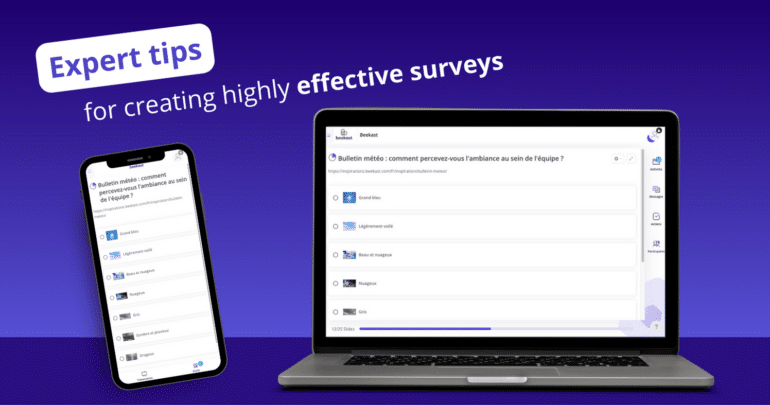Surveys often go underestimated, yet they play a vital role in collecting invaluable information for businesses. Whether you’re assessing customer satisfaction, gathering feedback on a new product, or enhancing employee engagement, mastering the art of creating effective surveys is crucial.
Crafting a survey that is relevant and well-structured demands a thoughtful approach. By leveraging the following tips and techniques we are about to share, you can maximize respondent participation, obtain high-quality responses, and fully leverage the wealth of data collected!
7 Tips for Creating Effective Surveys:
To maximize the effectiveness of your survey, it is crucial to organize it in a logical and coherent manner. Furthermore, actively promoting your survey through various communication channels can significantly boost participation from your employees or customers.
That’s why Beekast is delighted to offer you seven essential tips for creating highly effective surveys that are tailored to your specific target audience. These tips are designed to enhance the quality of your survey and optimize the insights you gather:
- Define the survey objective: Providing clear guidance to participants is essential for ensuring they understand the purpose of the evaluation and what you are seeking to assess. This targeted approach enables you to collect precise and meaningful data that directly addresses your research or evaluation objectives.
To set the right tone and motivate participants to provide relevant information, it is crucial to clearly state your objective at the beginning of the survey. By doing so, you emphasize the importance of their contribution and demonstrate how their input will directly impact the outcomes of the evaluation.
- Identify the target population: Indeed, considering the characteristics and demographics of your target population is essential when conducting a survey. This step enables you to tailor the tone, language, and types of questions to ensure a faithful representation of your sample compared to the intended population.
Selecting the appropriate sampling method is crucial for creating a successful and productive survey. It allows you to obtain a representative sample of the population, enabling effective market research without having to survey the entire population. This approach ensures that the insights and data collected are applicable to the broader group you are studying.
Additionally, to ensure that your survey reaches the right individuals and that the population is correctly filtered, you can implement measures such as using a password or an additional level of security. This ensures that only relevant individuals are invited to participate and respond to your survey, enhancing the quality and reliability of the data collected.
- Choose the type of survey: When conducting a customer satisfaction survey, selecting the appropriate type of survey is vital. Different survey types are better suited for specific scenarios, such as smaller or more representative samples versus larger populations.
Consider your target audience and objectives when choosing a survey type. For instance, if your target audience is geographically dispersed, online surveys, such as those created with tools like Google Forms, can be effective and cost-efficient.
When surveying your employees, it is crucial to specify the aspects that will be addressed. For example, if you aim to assess trends in work habits within your company, focus the survey on that specific topic. This approach allows employees to express themselves more freely and provide insights directly related to the subject at hand.
- Designing clear and concise questions: Whether you use closed-ended or open-ended questions, clear question formulation is essential. It ensures that participants understand what is being asked of them, reducing the risk of misunderstandings and inconsistent responses.
When using closed-ended questions, it is important to minimize the use of technical terms that may confuse or mislead respondents. Keeping the questions concise and using simple language helps participants save time and respond more accurately.
Additionally, it is crucial to limit the number of questions in the survey to prevent participant discouragement and high dropout rates. Creating a survey that is easy and quick to complete for all participants enhances engagement and ensures a higher completion rate.
- Avoiding biases in questions: Avoiding biases in survey questions is crucial to maintain the validity and reliability of the survey results. Biased questions can introduce specific opinions, values, or orientations that may influence participants’ responses, compromising the objectivity of the data collected.
For instance, it is crucial to avoid asking questions with limited response choices, as this may prevent participants from providing answers that truly reflect their opinions. Ensuring the right questions are asked is vital to obtaining unbiased results. Moreover, it is essential to carefully consider the survey audience to avoid biased outcomes. For example, surveying only users of a specific product to assess its overall quality could lead to skewed results, overlooking the perspectives of non-users or potential customers.
When utilizing rating questions, maintaining balance in question formulation is key. Instead of restricting responses to just 3 or 4 choices, provide multiple options to grant participants the freedom to express their opinions more comprehensively.
- Testing the survey: Before launching your survey, it is beneficial to test it with a small sample of people to identify any potential issues or ambiguities in the questions and make necessary adjustments.
This initial test offers several advantages, such as checking the relevance of the questions asked, ensuring efficient and accurate data collection, and evaluating the time required to complete it, providing valuable insights for participants.
- Analyzing the results: To make well-informed decisions, it is essential to carefully analyze the results of your survey. This crucial step provides valuable factual data and helps identify trends, patterns, and key findings.
By analyzing the results, you can generate detailed reports and evidence-based data, which can be effectively communicated to a broader audience. This emphasis on evidence-based data enhances the transparency, objectivity, and credibility of your study, making your findings more reliable and trustworthy.
By following all these best practices, you will be able to create effective surveys that provide valuable information for making informed decisions. Surveys can be used in various contexts, whether it’s to propose a new product or develop a new strategy.
Furthermore, Beekast offers the “Form” activity that can be customized according to your objectives and target audience. You can simply add your questions and options, and Beekast takes care of the rest. The responses can be displayed in different ways, and you can also obtain an Excel report for better analysis of the results.

